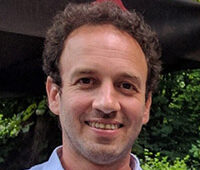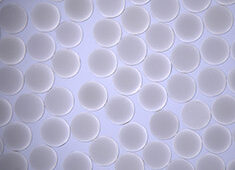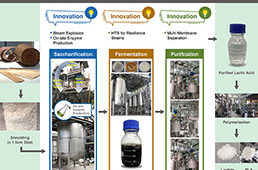Laser-based ultrasonics provides a high-sensitivity, non-contact technique for non-destructive evaluation of materials.
 |
| Figure 1: (a, top) The calculated time domain displacement response in a 5-µm copper-filled TSV as a function of propagation distance and (b, bottom) the propagation velocity as a function of frequency for the lowest and second lowest modes. Images: Rudolph Technologies Inc. |
 |
The need for improved performance of devices has led to the development of 3-D stacking of chips. Through-silicon via (TSV) has emerged as a viable and preferred technology for achieving such high-performance devices due to its short wiring length and reduced resistance and capacitance (RC) delay. It also offers the most design flexibility, lower manufacturing costs and allows for integration of heterogeneous chips.
One of the critical steps in the TSV manufacturing process is achieving a void-free fill of the high aspect ratio vias during plating. Although the presence of small voids has only a negligible effect on the TSV electrical resistance, void growth and migration during subsequent processing will affect the TSV reliability. Most methods currently available for the detection of voids in TSV are destructive and require extensive sample preparation—such as focused ion beam scanning electron microscopy (FIB-SEM) and x-ray tomography—or lack the resolution needed for detecting sub-micron voids (conventional scanning acoustic microscopy).
Laser-based ultrasonics is a high-sensitivity, non-contact technique for the non-destructive evaluation of materials with excellent temporal and micron-scale spatial resolution. A pulsed laser source irradiates a specimen surface where some of the laser energy is absorbed, leading to local thermal expansion and elastic wave generation through the thermoelastic effect. The amplitude, frequency content and directivity of the generated acoustic modes depend upon the laser spot size and pulse width, the optical properties of the sample surface and the thermal and mechanical properties of the heated region. The elastic waves are detected on the sample by monitoring the sample surface displacement, velocity or reflectivity using a second optical probe. Sensitive optical detection of ultrasound in the megahertz (MHz) to gigahertz (GHz) frequency range can be achieved using optical interferometry. Through evaluation of the velocity, dispersion characteristics, scattering and attenuation of ultrasonic waves, various physical and material properties can be determined.
In TSV evaluation, an effective measurement strategy is to excite elastic waves with a laser source on the top of a copper-filled TSV and detect the resulting TSV surface displacement as a function of time. A copper-filled TSV acts as an elastic waveguide, and the propagation characteristics are governed by the reflection and refraction of waves at the copper and oxide/silicon boundary. Elastic waves propagating in such a cylindrical waveguide are dispersive, meaning the phase velocity depends on frequency.
 |
| Figure 2: (a, top) Echo analysis of the signal measured on via with a defect ~70-µm deep. Round trip echo reflected from the small void (~0.054 µsec, 170.6 MHz) and from the via bottom (0.078 µsec, 144.8 MHz) are observed. (b, botom) FIB-SEM from the same via shows excellent correlation and validated our measurement capability. |
 |
In order to better understand wave propagation in TSV structures, a numerical model has been developed using explicit time domain, finite element modeling (FEM) and the PZFlex code (Weidlinger Associates, Mountain View, Calif.). A 5-µm copper-filled TSV surrounded by silicon was used. Laser heating of the free TSV surface produces rapid thermal expansion followed by a comparatively slow cooling. The rapid thermal expansion generates elastic waves, which propagate through the TSV, and the material displacement normal to the TSV surface is calculated as a function of propagation distance.
The results are given in Figure 1(a) for propagation distances between 100 and 350 µm. From these time domain responses, the dispersion curve, giving the explicit dependence of phase velocity on frequency, has been calculated and is shown in Figure 1(b). It’s found that the excitation source primarily generates a single mode in the TSV; the lowest order longitudinal mode. The second longitudinal mode is also generated, albeit with much smaller amplitude. The first mode shows strong dispersion, with the higher frequencies propagating significantly slower than the lower frequencies, which leads to the broadening of the wave packet with propagation distance observed in the simulation results. The fact that elastic waves can be excited by a pulsed laser source and guided along TSV structures opens the possibility of using them to probe high aspect ratio copper-filled TSVs for the presence of defects. In particular, poorly filled TSV structures and/or the presence of voids within the copper fill will lead to scattering and attenuation of the guided elastic waves. In this approach, the guided wave is detected by monitoring the displacement at the TSV surface subsequent to laser excitation.
For a defect-free via, the generated wave will propagate through the TSV, reflect from the bottom of the TSV and return to the sample surface where it’s detected. The expected time domain response will depend on the TSV height, or total round trip propagation distance. In poorly filled TSV structures, on the other hand, the transmission of guided waves through TSVs will be suppressed through scattering of the waves at the interfaces associated with inhomogeneities within the structure. In addition, the waves reflected from inhomogeneities in the TSV will have a different temporal signature than those from the TSV bottom due to the different propagation distance and dispersive nature of the wave propagation.
The net result is the laser-induced acoustic response allows for a clear distinction between filled and poorly filled TSV structures. Shown in figure 2(a) is an example from a TSV structure showing two distinct echoes; one from the voids in the TSV structure (0.054 µsec corresponding to a depth of ~70 µm) and the second a round trip from the via bottom (0.078 µsec corresponding to a depth of ~100 µm).
Using this technique, we have successfully measured TSV structures on as-plated, annealed samples, as well as on post-CMP wafers. The advantage of measuring on as-plated samples is to characterize the voids and provide early detection, as it’s well-known that the void growth phenomenon can potentially accelerate electromigration or stress migration failures, leading to device degradation and premature failure.




